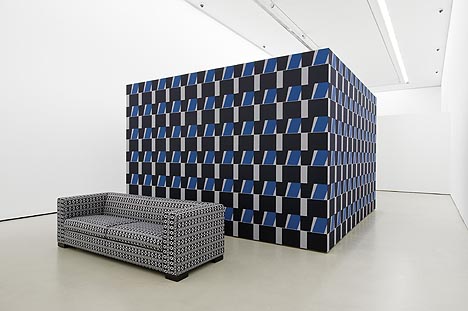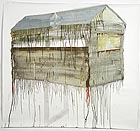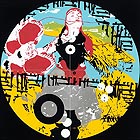
translated and summarized by: Liz Wollner-Grandville,
English summary October 26 - 31
MUMOK Museum moderner Kunst: Thomas Demand – Presidency. Embassy
Forged history
The Mumok Factory is currently showing the photographic works “Presidency” (2008) and “Embassy” (2007) by the renowned German artist Thomas Demand. The small display refers to other exhibits of the 45-year old “sculptor” and photographer, whose works are currently also shown in his large solo exhibit “National Gallery” in the Mies van der Rohe building in Berlin, as well as at the Palazzo Strozzi in Florence.
In five large-format photo tableaus, “Presidency” depicts the perfectly tidy and spiritless interior of the Oval Office at the White House. Demand offers the onlooker, similar to a guided tour, a detailed view of the centre of power. At a closer look, however, his photographs are irritating. You will detect traces of glue on the lamp, and the switch looks like it was mounted at a later stage. With these discoveries, the observer is on the right track regarding Demand’s artistic aim, as the Oval Office turns out to be a Potemkin village. Demand meticulously reconstructs the original location out of paper and cardboard, takes a photograph of his construction, and then destroys the cardboard scenery. What remains are large photographs.
Demand usually finds his motives in printed media. But this time the New York Times Magazine commissioned him to present the Oval Office in the typical Demand-Method. Only five days after the 2008 elections, Demand’s installation on one of the hot spots of world power was published as the cover story in the NY Times Magazine.
The photograph of Hitler’s bombed out headquarters clearly shows that Demand not only tries to satisfy his childlike pleasure in reconstruction, but also offers a certain historicity and its artistic paraphrasing. When asked about moving around inside these models he said: “when I run around in them, I somehow feel out of line. I transpose myself into a time and into a location, where I could have never really been.”
Sometimes Demand plays a more active role in his happenings, as is the case in his second work “Embassy”.
Here Demand documents the Embassy of the Republic of Nigeria in Rome, from where the stamp, the official seal, and the letterhead paper were stolen in 2001. Shortly after the theft, documents adorned with the stolen seal, letterhead and stamp confirming the purchase of enriched Uranium by Saddam Hussein showed up. Despite the suspicion of forgery, George W. Bush based his declaration of war against Iraq on these documents. Since no photographs of the Nigerian Embassy were available, Demand managed to get in and later reconstructed the rooms from memory.
The final product “Embassy”, which comprises 9 photo tablets, creates, similar to the Oval Office, an emptied and abandoned impression of a historic site.
By Susanne Rohringer
MUMOK Museum moderner Kunst
1070 Vienna, MuseumsQuartier, until 29.11.09
www.mumok.at
Belvedere: Viennese Showroom
“Improved Living” at the Belvedere
“The unexpected, which you expected” – Art by the meter
The exhibition promises to be a balancing act between art and design. “Art is useless and occupies space, which is separated from the space of functional objects”, Richard Artschwager says about dealing with art objects, which - as in his case - are hardly indistinguishable from furniture design.
Therefore, the question of art must be considered in a context: at a furniture fair, the “showrooms” would only be seen as cool fair stands and the cloth collections would only be discussed in the context of fashion trends, while at an art exhibit such as this one, the “personal positions” of the artists are questioned.
The curator, MUMOK director Edelbert Köb, currently still in office, gathered numerous of his favourite artists - all closely connected to Backhausen, a company renowned for its textile art tradition - to establish a contemporary line. Wittmann offered to cooperate with its furniture creations.
Who would be able to continue the good old days of the Wiener Werkstätte? Not textile designers, but artists who have already become brands, are of interest for the design market. During the 1980’s, the game with decorations by neo-geo-representatives, such as Kogler and Rockenschaub, was already popular.
Peter Kogler extends his existing textile collection with computer graphics, which was recently displayed as wallpaper at his solo show at the MUMOK. This space made up of topological convolutions becomes even more flowing in its textile transformation. By lighting a carpet with a pixel brain structure (Tai Ping) with the help of a naked light bulb he produced the association of light in a higher dimensional space.
Gilbert Bretterbauer covered the space with a net of intertwining circles made of colourful satin-ribbons. Behind the net, the objects with their excessive patterns seem to interfere with one another in a psychedelic reality, across flowing borders. This is contrasted by Irene and Christine Hohenbüchler’s small table object with the words “emptiness…vacancy” sawed out, as well as by Florian Schmidt’s wooden wall.
Florian Pumhösl transforms sophisticated weaving flaws into a design element and satirizes the aesthetics of a fair berth. An attitude of art rejection, which is only surpassed by the “service provider” personally: Gerwald Rockenschaub places Friedrich Kiesler’s sofa with its “candy covered conspiracy”-pattern in front of a strictly blue-gray-black cube pattern covered berth. The style of his cloths matches those of the Wiener Werkstätten tradition, and are suitable for every executive office floor.
Esther Stocker commensurately designs all interior spaces of her abstract room with table and lamp elements. Her otherwise crude black beams are transformed by a delicate cloth design.
Lisa Ruyter transformed a moody childhood memory – the cheering crowd at a concert – from a pop-like painting into a figurative ornament, which was realized in harmonious, warm earth tones as costly Jacquard looms.
In any case - the viewpoint is decisive if this is an art show or applied art. Marcel Duchamp, the “inventor” of this balancing act, once demanded that the recipients should always be involved in the production of art and this time they can even take the applied art home, without any limit, “everyone to his own taste”, by the meter.
By Renate Quehenberger
Belvedere
1030 Vienna, Prinz-Eugen-Strasse 27, until 24.01.10
www.belvedere.at
Startgalerie im Museum auf Abruf: Petra Schweifer – Schreihaus
Successful at second glance
The first impression of the works by the young artist conveys chaotic sketches and half-finished pieces. This impression is enhanced by the unusual hanging of most of the works, which seem coincidentally grouped and only seemingly abstract, and fill almost all of the gallery walls. But after taking a closer look one discovers the delicate aesthetics of the individual pieces. Such as the tiny and wonderful minimalistic picture titled “Threads”, showing a white object, resembling a house, balanced on four delicate stilts. An increasing number of appealing works are discovered among the various sized oil and tempera paintings when undertaking an expedition through the chaotic-dense hanging of the artist’s oeuvre. As so often, the smaller formats, like the 30 cm oil painting without a title and depicting the resemblance of a bluish tree – are consistently the ones that are most convincing.
The paintings, which all insinuate buildings, landscapes, or trees convey their beauty only at second glance; with some of the most outstanding works even reminding of Max Weiler’s paintings. Although if it is not always clear with the first impression, Petra Schweifer’s compositions always deal with landscape painting in the broadest sense; something that is confirmed by poetic titles such as “Steine springen” (stones leap) or “Das Meer ist heute auf der rechten Seite” (today the sea is on the right side).
The unpretentious, one could almost say discrete form of painting requires a great deal of preparedness to indulge in her picture language and logic, but one is definitely rewarded with surprising insights.
By Walter Pichler
Startgalerie im Museum auf Abruf
1010 Vienna, Felderstrasse 6-8, next to the Town Hall
until 05.11.09
www.musa.at
hilger contemporary: Oliver Dorfer – The palemoon, pulp, and other projects
Fabulously endued light
In the press release to this exhibit, Oliver Dorfer is quoted as saying that a painting includes a fair amount of purely visual information, which should evade being cannibalized through language. But one should talk about it - not as if one were at the butchers’ in a greasy, gristly, chewy way, and not in rhymes. All in all, it is a general rule that secret celebrities can be more harmful than useful, language can be transported on greasy leaves, but doesn’t have to, and that talking about painting in front of good painting is only necessary if one has seen what The palemoon-, pulp and other projects is all about.
The exhibition presents paintings put together of up to six large tablets. It deals with painting of acrylic on acrylic – amalgamated, joined and combined plastic material with pigments. Painting is sticky cream made of coloured powder and an adhesive sauce, which – when later spread on surfaces, interrupts the wall as a painted object, so that light experiences some variation as well as the onlooker. He, who uses a transparent surface like Dorfer does, works in the retro-technique of reverse glass painting – the last portion of smeared powder cream is tightly glued and visible on the reverse side. The first layer remains immutable on the front – or must be scratched or eliminated. An inevitable requirement for this kind of a visible form of painting is the adventurous prospect of the visual presence and significance of the respective layer of colour, but also on the commitment of form and line between the individual colour layers. Carefully developed and modest as well as playfully implemented lines supplement the emblematic and corresponding proportions of colour tones, a scale of the sparingly used prime colours white and black, which frame the dreamlike deep, yet obviously scratched, painting. And the glass provides a transparent and at the same time tangible distance. A kind of upside down binocular-effect and the associative haziness of a multiple exposure evolves.
The ciphers and figures, faces, landscapes, bodies, motions and nominations of the pictures are left to a special exploration, by which they catch attention through one or the other contrast. This happens on a very personal level and is equally as unnarratable as a sweet French kiss-fairy tale, but just as worthy of being narrated. Because: it reminds of the significance and the mercy that fills the conversation between the world and humans in enlightened moments - quasi meringue between the lines. Successful painting, well dressed and regardless of the lighting, deals exactly with this notion.
By Gesche Heumann
hilger contemporary
1010 Vienna, Dorotheergasse 5, until 17.11.09
www.hilger.at
Mehr Texte von translated and summarized by: Liz Wollner-Grandville


 Teilen
Teilen




